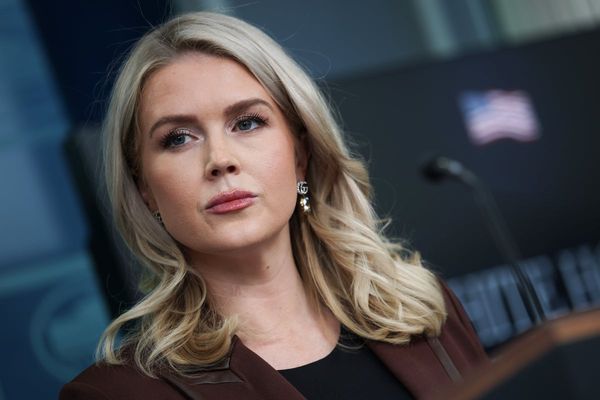
On the night of 3 October 1981, a group of white-hooded racists burned a 25-ft cross wrapped in burlap and drenched in kerosene until it lit up the North Idaho sky. It was a ceremony: the commemoration of the Ku Klux Klan uniting with the Aryan Nations in eternal hateful brotherhood.
Bill Morlin was a 34-year-old newspaper reporter for the Spokane Daily Chronicle in the small city of Spokane, Washington, then. He also covered the Idaho Panhandle, an isolated region known for its pristine lakes, rugged forests and people who prefer to live far from the rest of society.
The night the cross was burned, Bill had been sneaking around the Aryan Nations to covertly report on the event.
The next day, photos of the blazing cross taken by another reporter, Herta Long, ran on the front page of the Chronicle, and Bill published a first-person account of the evening. He concluded that while “… the flames of Saturday night’s cross might be out … the kind of needless hatred and bigotry they spread apparently isn’t going to be quickly snuffed”.
He couldn’t have been more right about that.

I was two months old when the cross-burning unfolded. I was born in New York to a progressive middle-class white family, far from the Idaho Panhandle. Later, I was raised in Oregon, and grew up believing racists wore white hoods or swastika armbands – a fading remnant of our past that would be immediately recognizable if they ever surfaced again.
I couldn’t have been more wrong about that.
For decades, Bill’s work proved the opposite. By the time I met him, I was 36 – and he had been writing exclusively about extremists my entire life.
When I was in the fifth grade, Bill wrote about the man at the center of the 1992 Ruby Ridge standoff for months, long before any bullets flew.
When I was a middle-schooler, reports initially called the 1995 Oklahoma City bombing the work of jihadists. Bill could smell the reek of far-right militia on the tragedy. His hunch was right.
By 1996, when violent racists placed a bomb outside the Spokesman-Review office, it was intended for Bill. I was a freshman in a Catholic high school then, smitten over the idea of one day becoming a journalist.

•••
I first crossed paths with Bill in the winter of 2017. We were both in Las Vegas to cover the federal trial of the notorious Bundy Family, a deeply religious, rural group who had engaged in an armed standoff with federal agents three years prior near their Nevada ranch.
I had worked for years in Spokane as a features and music writer for the alternative newsweekly, so of course I knew who Bill was; every journalist there knew of him, and respected his reporting. He had better sources than anyone, better scoops, better ideas. His unflinching reporting on the Aryan Nations and its splinter factions took pieces out of the group, which steadily declined until a lawsuit shuttered the place in 2001 and bulldozers reduced the buildings to rubble.
In Las Vegas, I introduced myself before court one day, and he asked who I was writing for.
“Longreads,” I told him.
“Long leads?” he asked, perplexed.
“Longreads,” I said. “Like, long journalism.”
He wrote it down on his notepad.
By then, I was covering extremism by accident. I was a freelance journalist who took breaking news assignments to cobble together a living, which is why I covered another long federal trial involving the Bundys after they led a 41-day takeover of a federal property in Oregon, believing the federal government is not allowed to own land.
That trial had rewired me, dominated my thoughts. I had been educated by religious people, and could see a tinge of religious ideology in the beliefs of the men and one woman on trial. The Bundys spoke about their opposition to the federal government with a fervor that felt dogmatic. They used words to talk about the land that felt biblical. They weren’t beliefs they read about online, or in passing conversation. Instead, it seemed like they had been spoon-fed to them since the day they were born.
Eventually, I would sit on the brown leather couch at the Bundy’s Nevada ranch to ask them: did their religious beliefs lead them to take up arms against the government? Proudly, they told me yes.

And so I fell backward into the extremism beat. A few stories about that federal trial became a years-long interrogation of the ways extremism is baked into our culture, the ways it comes from pulpits and memes, the way it seems to be in the wind in some places in the west.
For four years after our meeting in Las Vegas, Bill and I were in regular contact. We traded tips and brainstormed angles, we scoured documents and bitched about editors.
Until I met Bill, journalism was a patience game involving mostly male editors telling me what to do, often rolling their eyes at my ideas. Bill was different. He never talked down to me, never doubted my reporting instincts. He spoke to me like a colleague. Our age difference never came up. I had accidentally found a mentor.
He understood that when you cover extremism, it bleeds into your life. The hateful things you hear and see become etched into your brain and start to taint the way you see the world. He told me that when it got to be too much, he would retreat to his woodshop for “sawdust therapy”. I took up pottery. I learned from him that this path required balance, that hunting hate has to be evened out with constant search for happiness and light.
To do this work, you absolutely must believe that it can make a difference – that it will inform people, expose those with bad intentions. You have to know that revealing the uncomfortable truths about our culture and the hate that persists in this world is the only way to start making changes. That turning your back on it will not make it go away. Bill watched extremists’ every move, and when they died, he watched their gravestones – finding stories and new connections in the racist totems and notes left by followers and mourners.
If you don’t believe in the work, why else would you spend your days embedded in chats filled with racist memes, sit through interviews with people spouting hate, listen to audio files of racist preachers? Because make no mistake – this work will make you sick, it will haunt you. A full immersion into hatred will start to rot you from the inside if you’re not careful.
•••
In early 2020, I told Bill I was planning to write a book on the strange case of Lori Vallow, a Mormon mother who had disappeared after police in southern Idaho came looking for her young son and teenage daughter, whom no one had seen in months. People suspected that the family’s disappearance had to do with her “cult-like” religious beliefs.
The case had echoes of previous stories Bill had covered: of a fringe Mormon man and his wife, whose beliefs led her to throw each of their children from a Salt Lake City balcony in the 1970s; of a serial killer who had murdered and kidnapped his way across the west in the early 2000s, believing he was being guided by God.

In June 2020, the bodies of Vallow’s two children would be dug out of shallow graves in her husband’s backyard. The little boy was in his pajamas; the teenage girl was mutilated beyond recognition. Vallow and her husband, Chad Daybell, have been sitting in jail cells ever since, the wait for a trial dragged out for years by Covid delays and, eventually, death penalty charges for both. Nonetheless, Bill prodded me to keep pushing through.
In October 2021, I sent him my manuscript and I didn’t hear anything back. I got worried, but it turned out he had been reporting a story and just had not had the time to respond.
Later, he sent a photo of the printed manuscript, which he’d taken to a nearby copy shop to get spiral-bound. “Easier on my old eyes,” he said.
A few days later, though, I received a phone call from his wife, Connie. Bill had been hospitalized suddenly. Something about his gallbladder. Sepsis. He had instructed her to call me from his hospital bed. He wanted me to know he would need a little more time to get feedback to me on the book.
He died two days later.
I was paralyzed by the news. It felt impossible. How exactly could something as small as a gallbladder take down a giant? All I could think was I don’t think I can do this without you.
After enough time, I felt my sadness morph into anger – an old familiar feeling that drove me when I was young, one that I had to put aside to do the work of a reporter.
Since Bill died last year, a white supremacist murdered 10 black people shopping for groceries in Buffalo, New York, espousing views that used to draw people to the Aryan Nations. A man walked into a school in Texas and murdered 19 children and two schoolteachers, and the legislators of that state continue clinging to their guns – just like the anti-government movement always does. And earlier this month, police in Coeur d’Alene, Idaho – not far from where the Aryan Nations once stood – authorities pulled over a U-Haul truck. Piled into the back were 31 white nationalists who, police say, were on their way to start a riot at the local Pride Festival.

My anger lay solely on one question: how could a man write almost exclusively for 36 years about racism and extremism in America and die not seeing the problem go away?
What cruelty that was – to live a life so devoted to a cause, to have people hunt you, bomb you, and then, one day, die as the problem only seemed to be getting worse. All those years, Bill had been talking, and it seemed like finally people were ready to listen to him.
I let my vision go red. I let it push me to finish my book, diving into the deadly environment created by extreme religious ideologies and conspiracy theories.
I was angry that the story might forever be reduced to tabloid fodder, and determined to show there was something bigger behind the deaths of those children: it is about a system that permits violence, and a culture that allows it to thrive.
Bill knew that night in 1981, when the KKK burned a cross in Idaho, that those were only the embers of a fire that would burn long and hot in America.
I see it a little differently: that bigots and racists will do absolutely anything to achieve their nihilistic ends. That’s not a fire to be put out, but a value that must be unwoven from this society – thin threads that must be extracted from our very own flag.
On the day I finally held my book in my hands, I flipped to that last page, to my dedication to Bill Morlin’s memory. The book feels like a torch – one he lit so long ago, and which I carry on now, and that I’ll keep burning until the work is deemed obsolete. Until then, I’ll be the one stalking around the darkness, just like Bill.
• Leah Sottile’s book, When the Moon Turns to Blood, is out now







